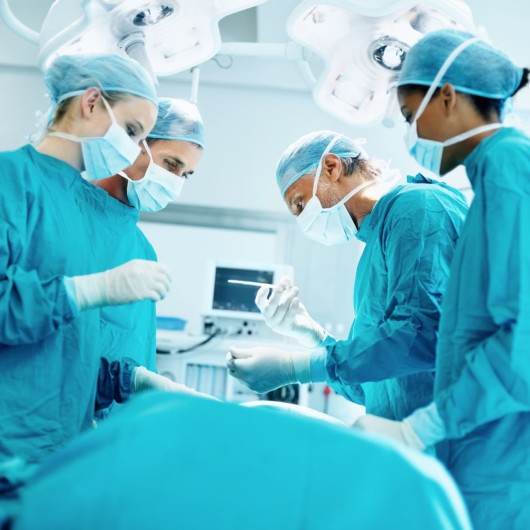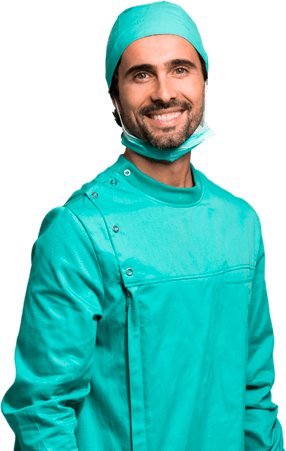
Robotic-Assisted Myomectomy (Da Vinci)
- Hospital stay: 5 days
- Surgery time: 1 - 2 hours
- Anaesthesia: General
- Surgical approach: Robotic-assisted surgery
- Full recovery: 1 - 2 weeks
Fixed price
22.600 €
All included
Consult financing conditions
Financing is available* for amounts over €150, and can be financed from 3 and to 24 months. The financing process is subject to approval by the collaborating financial entities. For further information on the financing conditions, please do not hesitate to contact us at +34 91 141 33 56 or through this contact form. Our Patient Service department will provide you with the information you need and explain the financing process. Find additional information about funding in the following link. *Operarme’s team manages the funding of surgical procedures and medical tests. The financing management of dental services is only performed at Caser Dental Clinics.
What do our patients think?
What is included?
-
Free surgical consultation
Request a free, immediate surgical assessment consultation with the Robotic Surgery Team.
Meet the specialist, assess your personal case with him, and together decide on the best treatment option for you.
-
Pre-operation study
A complete pre-operation study will be performed: including a blood analysis, electrocardiogram and chest-X rays.
Also a consultation with the Anaesthetist will be held to see if you are suitable for the surgery.
-
Surgical procedure expenses and fees
- Reservation and booking of the operation room, instruments, equipment,consumables and medication of the surgical procedure. Medication (non cytostatic nor monoclonal antibody or derivatives), medical gases,
- Stay in the postoperative recovery room, monitorization and necesary treatments, Pathological anatomy, haemotherapy-blood transfusions.
- Surgeon, assistant and anaesthetist fees until your medical discharge.
-
Hospital stay
The length of stay is 5 days in one of the Suite-type rooms at the private hospitals, with the option to add a spare bed for a companion.
-
Robotic-assisted surgery (da Vinci Robot)
The price includes the use of surgical instruments, operating room monitoring, and the Da Vinci Robot—one of the most important technological advances in the field of minimally invasive surgery.
-
Transfer service
Leave your car at home while you stay at the hospital. A free transfer will be organized for your hospital admission day and your return home after hospital discharge. Only available inside the metropolitan area.
If you would like to receive more information about this subject, please contact our patient service department.
-
Medical Complications insurance
Robotic-Assisted Myomectomy (Da Vinci) includes a medical complications insurance covering possible eventualities that may affect the patient during the surgical procedure and 30 days after surgical intervention, including reoperation if needed.
Medical complications insurance covers related surgical procedure expenses, such as:
- Increase in your hospital stay after surgery.
- Hospital admission after hospital discharge due to medical complications.
- Reoperation and hospital stay up to the established amount in the particular conditions.
Under no circumstances will be covered the emergency visits or medical review consultations after hospital discharge.
If you would like to receive more information about this subject, please contact our patient service department.
-
Post-surgical consultations
The number of post-surgical consultations included in the price of this surgery are 3. If more consultations are necessary, they must be managed through the Operarme patient service team and paid at a preferential price. For more information or request additional consultation, contact our patient service team.
Post-surgical consultations NOT included in the closed price of the surgical process have a price of €39 per appointment.
Information of Robotic-Assisted Myomectomy (Da Vinci)
- 01. Information about Robotic-assisted Myomectomy (Da Vinci)
- 02. What is a uterine fibroid?
- 03. Causes and symptoms of uterine fibroids
- 04. Surgical assessment consultation with the gynaecology specialist
- 05. Preoperative tests for robotic-assisted myomectomy (Da Vinci)
- 06. Robotic-assisted myomectomy (da vinci): step by step
- 07. Postoperative care for robotic-assisted myomectomy
- 08. Recovery after Robotic-Assisted Myomectomy (Da Vinci)
01. Information about Robotic-assisted Myomectomy (Da Vinci)
Uterine fibroids are non-cancerous growths in the uterus, classified as benign tumours that carry no risk of becoming malignant. This condition typically occurs in women of reproductive age, and the growth of fibroids may be influenced by oestrogen and progesterone—two hormones that the ovaries stop producing after menopause.
The size of fibroids can, in some cases, pose a risk during pregnancy or affect fertility.
Due to anatomical changes in the uterus, reproductive function may be compromised. Furthermore, if you are pregnant, you may experience severe pain during the second and third trimesters, especially if the fibroid exceeds 5 centimetres in size.
The Da Vinci Robot offers numerous advantages for performing a robotic-assisted myomectomy, which is the surgical treatment used to remove fibroids. Some of the most notable benefits of robotic-assisted surgery include minimal invasiveness, even in cases of large, multiple, or hard-to-reach fibroids.
After all, the Da Vinci Robot is technology originally developed by NASA to perform surgery in remote locations. We’ll go into more detail later about the advantages of using the Da Vinci system for myomectomy procedures.
In this guide, you will find comprehensive information about uterine fibroids, the robotic surgical option to treat this gynaecological condition, and the full surgical process offered by Operarme. So, if you’d like to learn more about robotic-assisted myomectomy, we invite you to keep reading.
02. What is a uterine fibroid?
A fibroid is a benign tumour located in the uterus. When referring to this gynaecological condition, we are not speaking of cancer, as uterine fibroids carry no risk of becoming malignant. Also known as leiomyomas or fibromyomas, they are the most common type of benign tumour found in the female pelvic area.
The uterus is primarily made up of muscle tissue. A uterine fibroid is an abnormal growth that develops within this muscular area of the uterus, typically appearing as a round-shaped mass. It is important to note that fibroids are composed of the same tissue as the uterus itself, but they form a denser mass.
Uterine fibroids may cause fertility problems and pain during pregnancy.
Although the exact causes of fibroid formation are still unknown, it is well established that female hormones—specifically oestrogen and progesterone—stimulate their growth. In some cases, when fibroids grow too large or become too numerous, they may affect fertility or complicate pregnancy.
The presence of fibroids has been closely linked to infertility in women, as the resulting anatomical changes in the uterus can interfere with the implantation of a fertilised egg.
Additionally, pregnant women may experience significant discomfort during the second and third trimesters due to limited space in the uterus—especially when fibroids measure more than 5 centimetres in size.

Are you interested in Robotic Myomectomy surgery?
Request a free assessment appointment with our Robotic surgery specialist now
03. Causes and symptoms of uterine fibroids
Uterine fibroids are a condition that occurs in women of reproductive age and are associated with the hormones oestrogen and progesterone. However, the exact cause of fibroid development remains unknown.
Their formation may be linked to genetic, hormonal, vascular, and environmental factors. Some of the main risk factors for developing fibroids include:
- Family history: Women with first-degree relatives—such as mothers or sisters—who have had fibroids are at a higher risk, as some fibroids appear to have a genetic component.
- Ethnicity: Although fibroids can occur in women of all ethnic backgrounds, they are more common in women of African descent. Furthermore, while fibroids typically develop in women in their forties, they tend to appear earlier—around the age of 20—in Black women.
- Pregnancy: Women who have never been pregnant or had their first pregnancy later in life are more likely to develop fibroids.
- Early onset of menstruation: The earlier a woman begins menstruating (menarche), the greater her risk of developing fibroids.
- Contraceptives: Hormonal contraceptives are sometimes used to reduce the risk of fibroids. However, beginning contraceptive use at a very young age—particularly before 16—may increase the risk of developing them.
- High blood pressure: Women with hypertension are more prone to uterine fibroids.
- Other factors: Lifestyle elements such as alcohol consumption, a sedentary routine, and obesity can also increase the risk of developing fibroids.
Also known as leiomyomas or uterine fibromas, fibroids are benign tumours that develop in the muscular tissue of the uterus. These lesions are non-cancerous in nature and very rarely become malignant.
Uterine fibroids develop slowly and usually stop growing after menopause. However, these benign tumours can sometimes lead to heavy blood loss which, in turn, may cause anaemia, fatigue, and—in rare cases—the formation of clots in the pelvic cavity.
Heavy bleeding is one of the main symptoms of uterine fibroids.
In some cases, fibroids may be asymptomatic and are only discovered during a routine gynaecological examination or as part of other abdominal assessments. However, in other cases, symptoms can range from mild to severe, or present continuously.
The type and intensity of symptoms depend on the size and location of the fibroid growth:
- Changes in menstrual bleeding: Fibroids can cause irregular or prolonged periods, bleeding between periods (known as cyclic or acyclic metrorrhagia, commonly linked to submucosal fibroids), or excessive menstrual bleeding (hypermenorrhoea), which is more often associated with intramural fibroids.
- Pelvic pain or lower abdominal discomfort: This occurs due to the pressure exerted by the fibroid on nearby organs. Pain may be felt in the pelvis, lower abdomen, lower back, or during sexual intercourse.
- Bladder pressure: Fibroids may press against the bladder, leading to difficulty urinating or, conversely, a frequent need to urinate.
- Rectal pressure: Uterine fibroids can also cause constipation, rectal pain, difficulty with bowel movements, and abdominal cramping.
04. Surgical assessment consultation with the gynaecology specialist
As with any surgical procedure that requires hospital admission, robotic-assisted myomectomy (Da Vinci) must be preceded by a thorough preoperative assessment. This ensures that both the surgery and the recovery process are carried out under the safest and most effective conditions.
Robotic-assisted myomectomy is one of the procedures offered through Operarme, in collaboration with our trusted partner hospitals.
For this reason, we provide a free surgical assessment consultation for robotic-assisted myomectomy (Da Vinci).
If you would like to book your surgical assessment consultation for robotic-assisted myomectomy, you can do so by calling our Patient Service team on +34 91 141 33 56, completing the contact form on our website, or clicking on the “Request Appointment” button.
Our patient service team will be happy to assist you and answer any questions you may have about Operarme’s services for robotic-assisted myomectomy.

Are you interested in Robotic Myomectomy surgery?
Request a free assessment appointment with our Robotic surgery specialist now
It’s important to note that this initial consultation is not for diagnosis or second opinions, but rather to assess the surgical need in your case of uterine fibroids. Therefore, you must already have a medical diagnosis confirming the presence of fibroids and indicating their severity.
This will allow the specialist to determine whether you are a suitable candidate for robotic-assisted myomectomy (Da Vinci) and, if so, proceed with planning the surgery.
Not all women are eligible for surgery using the Da Vinci robotic system, which is why this initial consultation is essential to evaluate whether robotic-assisted surgery is appropriate in your case.
05. Preoperative tests for robotic-assisted myomectomy (Da Vinci)
The preoperative phase for robotic-assisted myomectomy is essential to ensure the procedure runs smoothly and safely; that’s why Operarme includes all the necessary pre-surgical tests in the total price of the treatment.
The preoperative tests included in the Operarme package for robotic-assisted myomectomy (Da Vinci) are as follows:
- Full blood test – This includes a complete blood count, coagulation profile, and biochemistry. These tests allow the anaesthetist to assess platelet levels, detect any clotting disorders or signs of anaemia, as well as evaluate for infection or imbalances in blood electrolytes (such as sodium or potassium).
- Electrocardiogram (ECG) – Provides the anaesthetist with information about your heart rhythm, electrical conduction, structural abnormalities, and overall cardiac function to minimise risks during surgery.
- Chest X-ray – Allows the anaesthetist to check for any structural abnormalities in the chest, ensure correct alignment of the trachea, and rule out any potential signs of infection.
Consultation with the anaesthetist
After completing the preoperative tests, you will have a consultation with the anaesthetist. As robotic-assisted myomectomy is a major surgery, it is performed under general anaesthesia regardless of the surgical technique used.
Therefore, this consultation is essential to determine the appropriate dosage of anaesthetic medication for your specific case of uterine fibroids.
The main goal is to identify any potential risks that could affect the procedure, such as allergies to anaesthetic drugs, respiratory issues, heart conditions, and more. The anaesthetist will also review your preoperative test results to consider any factors that might influence the surgery.
06. Robotic-assisted myomectomy (da vinci): step by step
Robotic-assisted myomectomy is a surgical alternative to hysterectomy aimed at removing fibroids without needing to remove the uterus entirely.
This procedure is recommended for women who still wish to become pregnant or want to preserve their uterus for other reasons. Additionally, robotic surgery is an advanced, high-precision technology that allows complex surgical procedures through small incisions, making it the least invasive and most precise option available today.
The robotic-assisted myomectomy typically lasts between 30 and 120 minutes, depending on the individual case.
Upon arrival at the hospital, you will go to admissions and submit all the necessary documentation for the procedure. As you know, our Operarme patient service team will support and guide you throughout the entire process, so you only need to focus on your health.
Afterwards, you will be taken to the operating theatre with the medical team who attended your previous consultations, and you will be given surgical clothing to proceed with the robotic-assisted myomectomy.
The medical team is led by the gynaecology team, who control the robot from the console, assisted by one team member who manoeuvres the uterus and another who handles the laparoscopic instruments of the Da Vinci robot.
- The first to act is the anaesthetist you met during your consultation. They will administer the appropriate dose of medication, which will vary depending on your test results and your specific case of fibroids. As you know, the myomectomy is performed under general anaesthesia, regardless of the surgical technique used.
- Once the anaesthetic takes effect, the medical team will place the trocars for the robotic arms on your abdomen. These will be arranged in an arc from the right anterior superior iliac spine to the left, passing through the navel, with a port positioned for the assistant.
- When the fibroids are large, the tissue cannot be removed through the abdominal incisions. In such cases, they are extracted via the vagina, so the robot is positioned between your legs at a 45-degree angle from your position to allow better vaginal access.
- Next, the surgeon will view the pelvic structures and surrounding organs on the monitor to ensure everything is in order.
- The surgeon injects the fibroids with diluted vasopressin to reduce blood flow to the fibroid and minimise bleeding.
- An incision is then made in the myometrium, the middle layer of the uterine wall, using monopolar energy carefully without excess.
- The fibroids are removed using a traction and contraction technique until complete excision. Usually, the procedure starts with the fibroid closest to the cervix and gradually moves towards the uterine fundus.
- Typically, fibroids are removed through the incisions made for the Da Vinci instruments. However, when fibroids are disproportionately large, the best option is vaginal extraction. In these cases, a small opening is made at the top of the vagina, and the fibroids are removed through it.
- If several fibroids are removed, a drain may be left in place for one day, depending on your condition and the medical team's judgement.
- Finally, the robot is detached, and all instruments are removed so you can be awakened and taken to the recovery room to complete your recovery from the anaesthetic.
Once the procedure is complete and you have recovered from the effects of the anaesthetic in the recovery room, the medical team will transfer you to your room where you will stay until you are medically discharged.
Operarme includes up to 5 days of hospital admission following the surgery to ensure full recovery. However, this will depend on the doctor’s assessment, so in some cases, you may be discharged well before the 5 days are complete.
07. Postoperative care for robotic-assisted myomectomy
After completing the myomectomy and once you have recovered from the effects of the anaesthetic in the recovery room, you will be taken to your room where you may stay up to 5 days, depending on the extent of the fibroids present in your uterus. As this is a somewhat complex surgery involving the removal of abnormal tissue while aiming to preserve the rest of the organs, hospital admission is essential.
During your hospital stay, you will receive all necessary care to support your recovery. This includes meals, hygiene assistance, housekeeping, and everything else you may need.
08. Recovery after Robotic-Assisted Myomectomy (Da Vinci)
For surgeries such as robotic-assisted myomectomy, hospital admission is a crucial part of the process. Just like the duration of the procedure, the length of your hospital stay will depend on the technique used and the complexity of your individual case.
However, with robotic-assisted myomectomy using the Da Vinci system, hospital stays typically range from 2 to 5 days, which is shorter compared to other techniques that require longer admissions.
Immediately after surgery, you will be kept hydrated with intravenous fluids and started on a liquid diet after 6 hours. If tolerated, you will progress to a semi-liquid diet after 12 hours, then gradually advance to soft foods with more solid items, with full digestive function usually restored within 24 hours.
Regarding full recovery, if the procedure had been performed using a non-robotic technique, it would generally take about 6 weeks to return to normal activities.
One of the potential benefits of the Da Vinci robotic system is a faster recovery, often allowing you to resume your normal life within two weeks. Nevertheless, your doctor will ultimately decide when you are fit to be discharged.
The Da Vinci Robot is one of the safest techniques to address uterine problems such as the development of fibroids, performing robotic myomectomy.
However, as with any major surgery, myomectomy carries possible risks, although this procedure has a very low complication rate.
Some of these risks include:
- Blood loss. Women with anemia caused by heavy menstrual bleeding have a higher risk of this occurring. Nevertheless, the doctor may suggest ways to increase red blood cells before surgery or take additional measures to prevent excessive bleeding during the procedure.
- Scar tissue. Making incisions in the uterus to remove fibroids can lead to adhesions between structures near the lesions. However, with the Da Vinci Robot technique, the possibility of this happening is considerably reduced.
- Complications during pregnancy or childbirth. If the surgeon makes a deep incision in the uterine wall during the myomectomy, the doctor managing your delivery may recommend a cesarean section to avoid uterine rupture during labor. This complication is very uncommon. In fact, having fibroids during pregnancy poses a greater risk.
- Possibility (rare) of hysterectomy. In cases where bleeding is uncontrollable or other abnormalities besides fibroids are found, the surgeon may need to remove the uterus.
- Possibility (rare) of cancerous tumor spread. This is very uncommon because fibroids are rarely mistaken for cancerous tumors. In such a case, removing the tumor in small parts could potentially cause it to spread. The risk of this happening is very low.
If you have doubts about the specific risk percentage in your case, the surgical evaluation consultation with the specialist will help clarify this. As mentioned before, myomectomy performed with Da Vinci Robot technology significantly reduces the likelihood of any of these risks occurring.
If you want to request your surgical assessment consultation with the specialist, you can call our Patient Service phone number at +34 91 141 33 56, or fill out our contact form.

Are you interested in Robotic Myomectomy surgery?
Request a free assessment appointment with our Robotic surgery specialist now
Fixed price
22.600 €
All included
Consult financing conditions
Financing is available* for amounts over €150, and can be financed from 3 and to 24 months. The financing process is subject to approval by the collaborating financial entities. For further information on the financing conditions, please do not hesitate to contact us at +34 91 141 33 56 or through this contact form. Our Patient Service department will provide you with the information you need and explain the financing process. Find additional information about funding in the following link. *Operarme’s team manages the funding of surgical procedures and medical tests. The financing management of dental services is only performed at Caser Dental Clinics.
Step by step
-
Ask for a free consultation with our specialist in Robot Assisted Surgery.
-
Information will be sent to your email address.
-
We will call you to confirm the date.
-
Meet the surgeon and decide if you would like to have the surgical procedure with us.
-
Regain your quality of life.
What do our patients think?
Frequent Questions
-
Do I have to take a PCR test before surgery?
Currently our collaborating hospitals and surgeons do not ask patients to take a PCR test as a mandatory requirement to enter the operating room.
If exceptionally this test would be required by the hospital or surgeon, we inform you that the PCR test is not included in the price of the surgery.
If you have any questions about this specific issue, please contact our patient service department.

Robotic-Assisted Myomectomy (Da Vinci)
- Hospital stay: 5 days
- Surgery time: 1 - 2 hours
- Anaesthesia: General
- Surgical approach: Robotic-assisted surgery
- Full recovery: 1 - 2 weeks
Fixed price
22.600 €
All included
Consult financing conditions
Financing is available* for amounts over €150, and can be financed from 3 and to 24 months. The financing process is subject to approval by the collaborating financial entities. For further information on the financing conditions, please do not hesitate to contact us at +34 91 141 33 56 or through this contact form. Our Patient Service department will provide you with the information you need and explain the financing process. Find additional information about funding in the following link. *Operarme’s team manages the funding of surgical procedures and medical tests. The financing management of dental services is only performed at Caser Dental Clinics.


